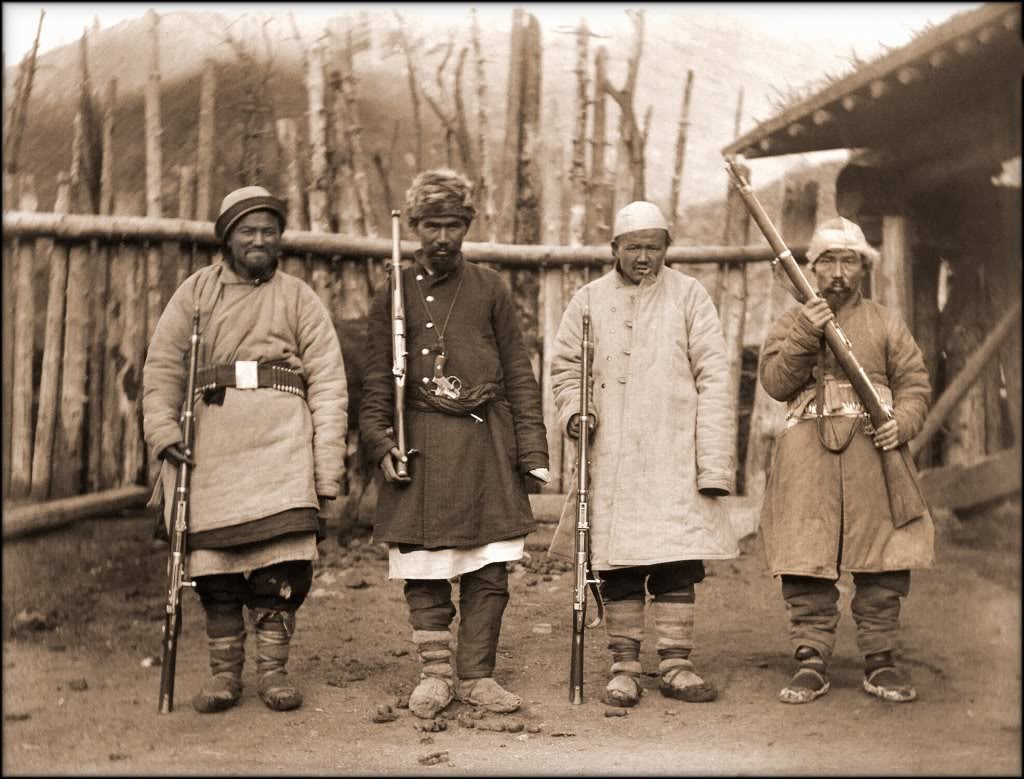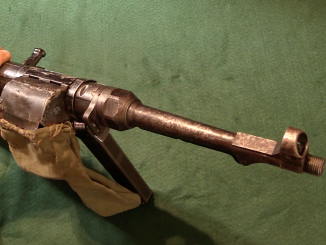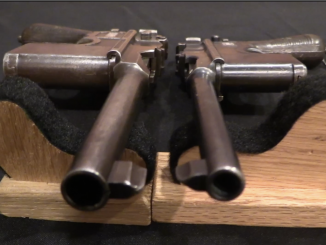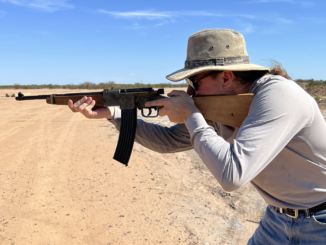
Full-length portrait of the four men, standing in a line with rifles. ‘While halting for the night I had an interesting opportunity of becoming acquainted with a small party of well-armed outlaws from Kara-khoja of whose presence on this much-frequented mountain route I had already been warned at Jimasa… They were the ‘die-hard’ remnant of a large party of Kara-khoja cultivators, who having had a long-standing dispute over some lands with neighbours of Astana… had about six months before attacked and killed the Muhammadan Jisa, the local revenue official, whom they believed to have brought about the defeat of their rightful claims…
They were well armed with Mauser rifles, for since the revolution of 1911-12 it had become easy to purchase arms and ammunition from the Chinese garrison at Turfan… Since removing themselves to a region outside the Turfan command, the four heroes had remained wholly unmolested. They were now maintaining themselves in comparative comfort at Pa-no-p’a by the receipt of charitable gifts from sympathizing fellow Muslims and of blackmail from other wayfarers…
Ahmad’s wish to meet me again during my winter’s stay in Turfan was to be realised in a fashion rather different from that he had in mind; for, on returning from Urumchi in the first days of January, I was greeted by his shriveled black head stuck up on a high pole outside the gate of the Yang-shahr of Turfan…’ (ii, 560, note). (I.A. Map 28, B1).
The second man from the left, Ahmad, has the symbols of leadership: a carbine (German Kar88) and pistol (appears to be an M1895 Russian Nagant). The other three men have M1871/84 Mauser rifles.
Thanks to Joseph for finding the photo!




Tough men in an unforgiving political climate — yet another piece of forgotten history in a forgotten region of the world. I think I’m going to spend a little time on this rainy Saturday re-visiting the history of that area.
Thanks for the post, Ian.
Wow!!
Seeing this photo I immediately thought of Roy Chapman Andrews exploring the Gobi Desert, .250-3000 Savage close at hand and sixgun hung loosely from the hip. Bandits beware!
How you you say “Bajes??? We don’ got no Bajes…we don’ need no steenkin’ BAJES!!!”
Broz
Black powder Mausers are still very deadly, even if outdated. Nobody wants to get 11 x 60 mm Mauser through the head! Any performance figures on the old round? I’d like to see a few numbers (rather than bullet holes through the wall).
German 11mm . MODEL 71/84 CARTRIDGE
Case Length: 60mm.
Over-All Cartridge: 3.01″
Cartridge Weight: 664 grs.
Bullet Length: 1.02″
Bullet Weight: 386 grs.
Powder Weight: 77 grs.
Bullet Nose: flat
Muzzle Velocity: 1443 fps (31.56″ barrel)
Or so I have read.
Where Mausers are outlawed, only outlaws will have Mausers…
Having spent 30 + years playing with various 11x60mm chambered rifles, I will say they are eaqual to or even a little more powerful than the USA 45×70.
The few good condition, original, black powder loaded, paper patched rounds I fired, Kynoch manufacture, were, in me opinion on a par with contemtorary loaded USA 45×90.
I have no figures to back up this opinion, it is just my impression.
I’ve always been fascinated by Central Asia.
I’m currently reading a book on Roman Nicholas von Unger-Sternberg, the “Mad Baron” of Mongolia.
Mongolia and Manchuria between the Boxer Rebellion and the Communist seizure of power in China were like a Clive Barker novel, only all of the monsters were human.
Correction: Roman Nicholas von UngerN-Sternberg.
Try to get copies of “Forbidden Journey” by Ella Maillart and “News from Tartary” by Peter Fleming. These two travelled together through northern Tibet and southern Xinjiang in western China, and then down into British India in the 1930s. It was a very turbulent time and the area was in revolt. There’s no gun play involved, but they give a very good description of the land and the people, and they have some very good photographs.
Maillert was the more practical of the two, and she probably gives a more detailed background to the place. Fleming was probably a somewhat livelier writer and his book is shorter, if you don’t want too much of a read.
Peter Fleming was the brother of Ian Fleming, who was a WWII spy and later the author of the James Bond novels. I suspect that both Peter and Ella may have been doing a bit of spying themselves on behalf of their respective governments despite their claim of having travelled there purely for the sake of writing travel books. The area was *very* dangerous and in the middle of a war at the time they went through.
Chris, Peter Hopkirks series on The Great Game should be just what you’d need as a follow up to the novel you’re reading. In several books he describes the secret war between Britain and Tsarist Russia in the lonely passes and deserts of Central Asia. I found them fascinating and well written.
Indeed Christian! I read all the books by Peter Hopkirk. Another title well worth reading is Jennifer Siegel’s “Endgame: Britain, Russia and the Final Struggle for Central Asia” (London: I.B. Tauris, 2002). I always found Central Asia (or Inner Asia, as the likes of Aurel Stein used to call it) in the Great Game era and afterwards, a fascinating subject.
And thanks to Ian for posting this wonderful photograph (and Joseph for finding it!).
R.
Strait out of a Stephen Becker novel. Very cool….
Yeah, I’ve always been fascinated by those tube-fed 11mm Mausers. As noted, I doubt if there was much difference if you were a hundred yards downrange between 11mm Mauser/ Spanish/ Egyptian and .45-70. Personally, for a day at the range or the annual date with Bambi, a 71/84 seems a lot more interesting than a 98.
On books about China… one of my favorite fell-between-the-cracks authors is Stephen Becker. Missionary’s kid (I think) who was a serious Asian-language linguist and wrote some fantastic novels about Americans in the Far East in the 1940s. “The Last Mandarin”, “The Blue Eyed Shan” and “The Chinese Bandit” are all highly recommended if you are a fan of good writing or just wish you had been running around Burma or China with a gun and an attitude in 1947. That summer they hanged a fat man at the west gate of the city…..
I’ve read several of Becker’s novels and they are indeed very good.
It is a pity the 71/84 is no longer made(like practically all of the lever guns of 1870-1890s), but you can still buy them at a reasonable price considering there age.
It would be fun to show up to a Cowboy Action Shoot with one!
For any one how wants to know more about the 71/84 and Black-Powder Mausers in general, Ludwig Olson’s Mauser bolt rifles is a good place to start.
China has always been one of Mauser¨s main markeds, so finding them in the hands of outlaws can hardly suprice anyone.
I’m sure the other three guys lived long, prosperous lives.